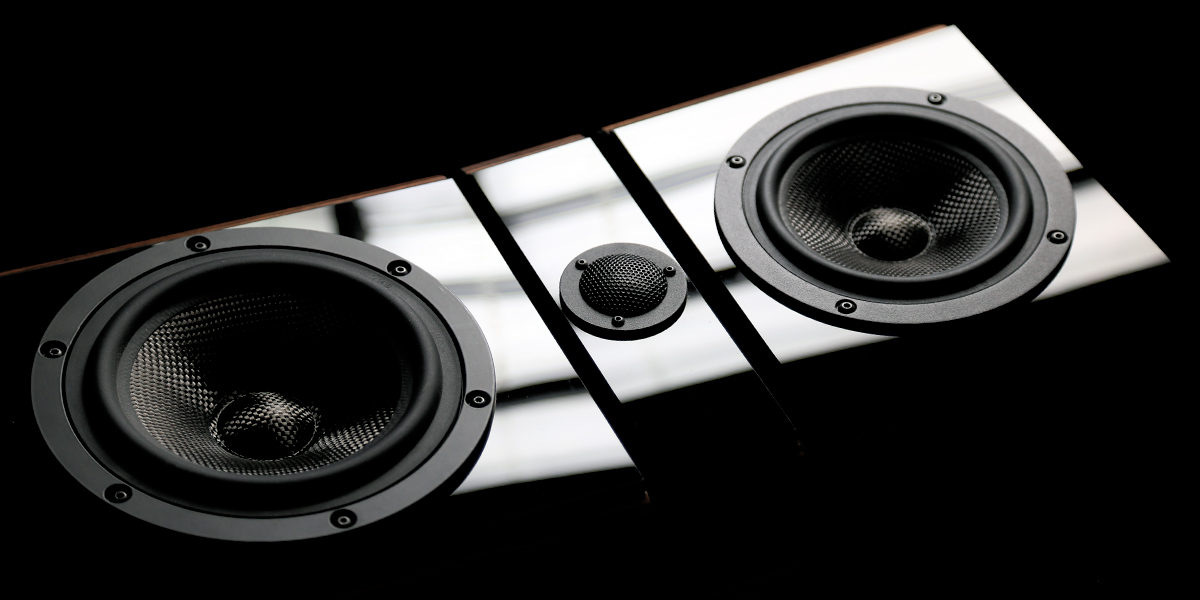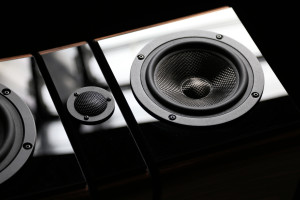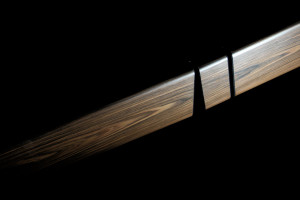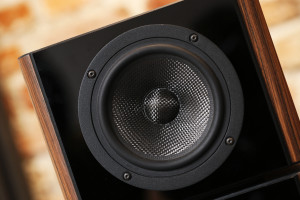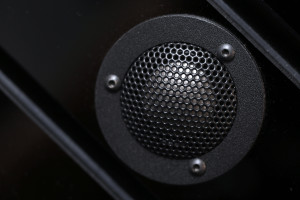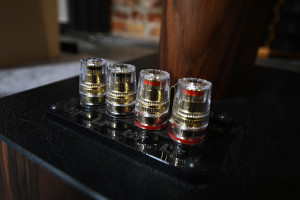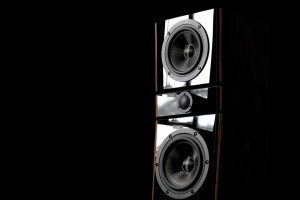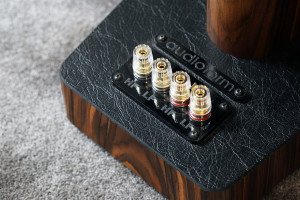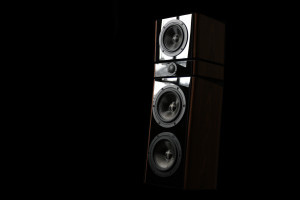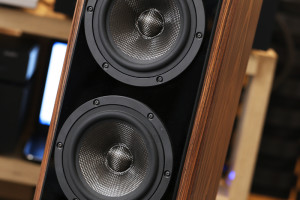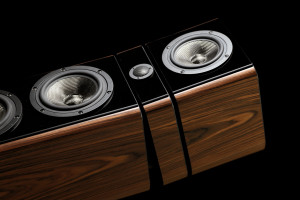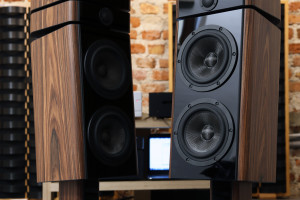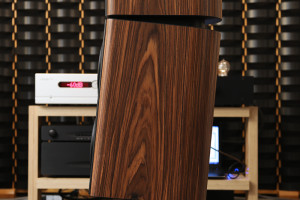What happens if one mixes a musician’s, an engineer’s, a designer’s and an audiophile’s approaches with roughly 12 years of speakers making experience? This review is the answer to said question and by that one should understand that Polish Audioform manufacture’s 203.5 floorstanders are served as said material’s main dish. Enjoy!
Introduction
I strongly believe that every person interested in high calibre audio knows, what Focal Grande Utopia EM is. These French state-of-the-art floorstanders are a true sight to be seen. It’s hard to shake off the feeling that with this design in particular, Focal has achieved something visually striking, appealing, fresh and, above all else, aesthetically different. Yes, no such thing as universal beauty exists, yet I honestly don’t think that there is a person who’d not be moved in any way in Grande Utopia EM’s presence. In my eyes, said model’s form has a very intense and somewhat intimidating vibe. During every occasion I’ve had a pleasure seeing it, I’ve always felt like a small kid in front of a giant. That’s my experience. Focal’s flagship model is visually so vastly different and peculiar in comparison to every other set of speakers known to me, that I believe it’s a perfect example of a timeless piece of art. But what if Focal wasn’t the first company with such design? I’m aware that it’s quite difficult to believe that this might be the case these days. But… what if?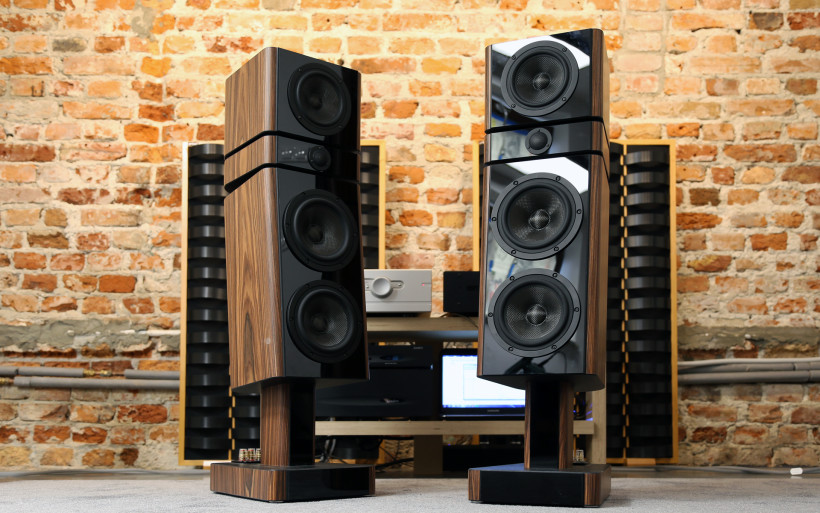 Let’s move to Poland for a while. Meet Tomasz Kursa, a skilled engineer behind Audioform operation located in Kraków city. I’ve stumbled upon his work not too long ago and by pure coincidence. One of recent HighFidelity.pl publications was devoted to one of its readers adventures. Said portal’s owner thought that aforementioned individual’s writing is a good story to share with broad audience, hence it went online. This article was actually a generously informative description about our audiophile’s room issues and how he handled these. In audio there’s a certain kind of awareness. Sooner or later, but when it finally arrives, one literally wakes up to realize that his setup’s performance might be (and probably is) bottlenecked by the environment. Very decent rig’s outcome mediocre at best because of the room itself? Yes, this can be the case. In order to prevent that, a specific treatment has to be done and that’s what our audiophile did in the abovementioned publication. Past personal capabilities and knowledge, research phase followed and Audioform company was his choice to check what’s what, find all troublesome buggers and do every professional deed necessary to make them gone. According to what’s written in HighFidelity.pl article, Tomasz Kursa delivered and with a bang. We won’t discuss here what kind and number of rituals and sacrifices had to be done to make the end of said story’s a perfectly happy one. But it’s worth to know who this gent is and what he does for a living.
Let’s move to Poland for a while. Meet Tomasz Kursa, a skilled engineer behind Audioform operation located in Kraków city. I’ve stumbled upon his work not too long ago and by pure coincidence. One of recent HighFidelity.pl publications was devoted to one of its readers adventures. Said portal’s owner thought that aforementioned individual’s writing is a good story to share with broad audience, hence it went online. This article was actually a generously informative description about our audiophile’s room issues and how he handled these. In audio there’s a certain kind of awareness. Sooner or later, but when it finally arrives, one literally wakes up to realize that his setup’s performance might be (and probably is) bottlenecked by the environment. Very decent rig’s outcome mediocre at best because of the room itself? Yes, this can be the case. In order to prevent that, a specific treatment has to be done and that’s what our audiophile did in the abovementioned publication. Past personal capabilities and knowledge, research phase followed and Audioform company was his choice to check what’s what, find all troublesome buggers and do every professional deed necessary to make them gone. According to what’s written in HighFidelity.pl article, Tomasz Kursa delivered and with a bang. We won’t discuss here what kind and number of rituals and sacrifices had to be done to make the end of said story’s a perfectly happy one. But it’s worth to know who this gent is and what he does for a living.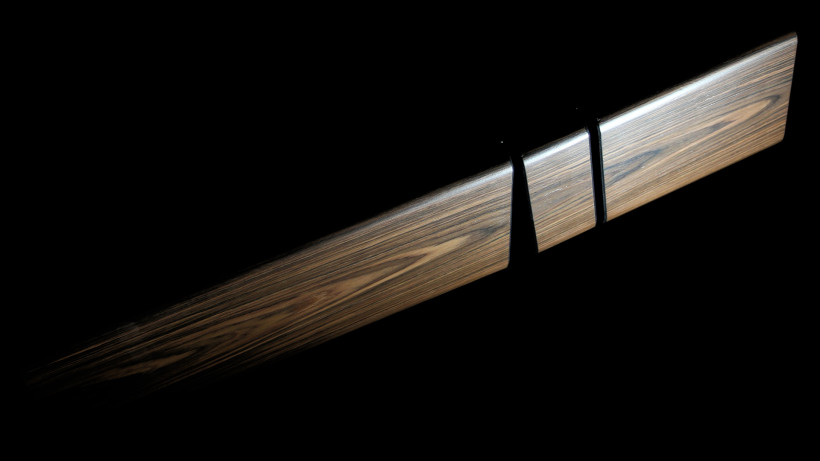 As he speaks of himself, Tomasz is interested in air. In its movement, to be exact. Or to put it simple, he’s the acoustics guy and as one, he takes enormous pleasure in finding solutions to picky audiophiles’ environmental problems. Boomy bass? Call Tomasz. Lousy stereo imaging? Call Tomasz. Incoherent, all over the place sound with glassy tint? Call Tomasz. Voices in your head? OK, this one he won’t solve, at least to my knowledge. But knowing how friendly our engineer is, he’ll at least search for a reputable shrink to fix said issue. Because, you know, he is a very helpful person, who takes audio enthusiasts’ wishes very, very seriously. To what degree? Heck, He’ll drive to your place to personally check what’s off in there. His exceptionally personal attitude, it simply rocks. During many calls with Tomasz, there were no ifs or buts, on the contrary to very direct and precise questions about my place. Once he gained proper knowledge, he concocted something fitting, but that’s a story for another time. What you need to know about Mr Kursa for now is that he’s not a hobbyist possessed by a DIY craze but a professional. Yet that’s still not the whole picture. Far from it in fact.
As he speaks of himself, Tomasz is interested in air. In its movement, to be exact. Or to put it simple, he’s the acoustics guy and as one, he takes enormous pleasure in finding solutions to picky audiophiles’ environmental problems. Boomy bass? Call Tomasz. Lousy stereo imaging? Call Tomasz. Incoherent, all over the place sound with glassy tint? Call Tomasz. Voices in your head? OK, this one he won’t solve, at least to my knowledge. But knowing how friendly our engineer is, he’ll at least search for a reputable shrink to fix said issue. Because, you know, he is a very helpful person, who takes audio enthusiasts’ wishes very, very seriously. To what degree? Heck, He’ll drive to your place to personally check what’s off in there. His exceptionally personal attitude, it simply rocks. During many calls with Tomasz, there were no ifs or buts, on the contrary to very direct and precise questions about my place. Once he gained proper knowledge, he concocted something fitting, but that’s a story for another time. What you need to know about Mr Kursa for now is that he’s not a hobbyist possessed by a DIY craze but a professional. Yet that’s still not the whole picture. Far from it in fact.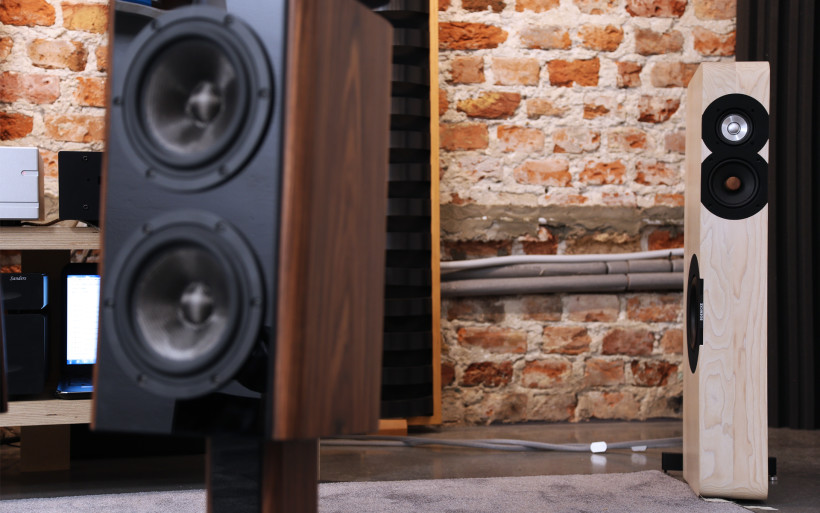 It’s safe to say that a mixture of musical skills and audiophile soul, often nets great results. When one is an engineer on top of that, the outcome might be grand. As an active musician, Tomasz Kursa knows very well how certain instruments sound like, i.e. drums, his specialty. Plus he knows a thing or two about materials processing and design overall. To check to what degree, short glimpse on his site is more than enough. When it comes down to just room acoustics, our engineer uses styrofoam. His CNC machined diffusers and absorbers are based on it. According to his words, this particular material is in 95% as acoustically efficient as solid wood, but times more affordable. Audioform portfolio consists of pre-made elements, though Tomasz is open to a custom job. When a room requires individual measures, he often suggests this route. Our client is our master and rightfully so.
It’s safe to say that a mixture of musical skills and audiophile soul, often nets great results. When one is an engineer on top of that, the outcome might be grand. As an active musician, Tomasz Kursa knows very well how certain instruments sound like, i.e. drums, his specialty. Plus he knows a thing or two about materials processing and design overall. To check to what degree, short glimpse on his site is more than enough. When it comes down to just room acoustics, our engineer uses styrofoam. His CNC machined diffusers and absorbers are based on it. According to his words, this particular material is in 95% as acoustically efficient as solid wood, but times more affordable. Audioform portfolio consists of pre-made elements, though Tomasz is open to a custom job. When a room requires individual measures, he often suggests this route. Our client is our master and rightfully so.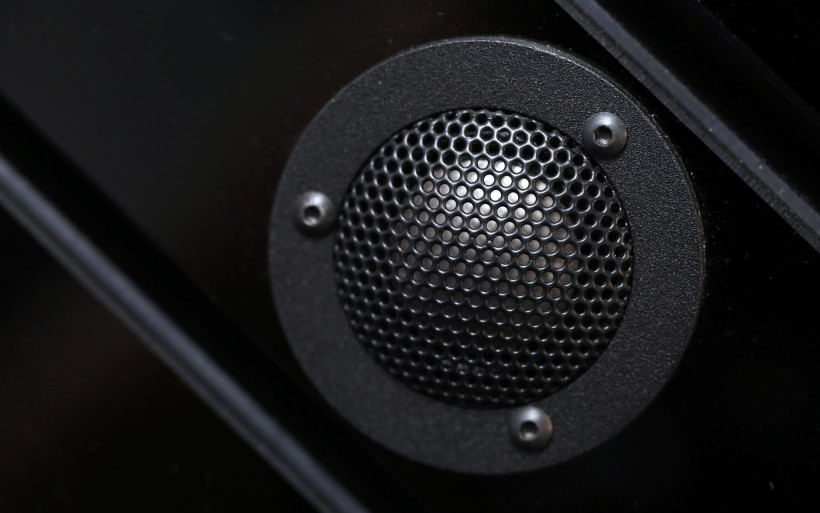 So there you have it, an individual who is a musician with extensive acoustics knowledge. Anything past these skills? Yes, one more thing that makes it all click. Tomasz also manufactures a very interestingly looking speakers. That’s not his core business yet, but, as the man himself puts it, he’s somewhere in between a DIY assembly and a professional operation. Rising star then? Perhaps, we’ll find out soon enough. At this point you must be wondering why this journalist kicked this review off with Focal accent. Well, Mr Kursa’s floorstanders resemble what French company does and in a rather obvious way. Therefore during his first visit at my place and past common courtesies, the very first thing yours truly said was a remark about that exactly: “Tomek, these look like Focals. You’re aware of that, right? You wanted to be seen as a manufacturer known for this very design exploitation or what?”. The man smiled and with exceptionally humble and calm look on his face replied: “You know, this Focal alike design was in my drawer for last twelve years, long before Grande Utopia series emerged. Only recently I was able to pull this off commercially and spread the word. But yeah, Focal delivered the goods on the market much earlier. Though my take on this audio case we’re talking about now is to focus on my own doing rather than be envious about what competition has”. Then we both laughed hard and for this journalist’s things became even more interesting from this point onwards. Humble constructor, curiously looking speakers, what more one could want? Without further ado, Audioform 203.5 is on the table in this writing.
So there you have it, an individual who is a musician with extensive acoustics knowledge. Anything past these skills? Yes, one more thing that makes it all click. Tomasz also manufactures a very interestingly looking speakers. That’s not his core business yet, but, as the man himself puts it, he’s somewhere in between a DIY assembly and a professional operation. Rising star then? Perhaps, we’ll find out soon enough. At this point you must be wondering why this journalist kicked this review off with Focal accent. Well, Mr Kursa’s floorstanders resemble what French company does and in a rather obvious way. Therefore during his first visit at my place and past common courtesies, the very first thing yours truly said was a remark about that exactly: “Tomek, these look like Focals. You’re aware of that, right? You wanted to be seen as a manufacturer known for this very design exploitation or what?”. The man smiled and with exceptionally humble and calm look on his face replied: “You know, this Focal alike design was in my drawer for last twelve years, long before Grande Utopia series emerged. Only recently I was able to pull this off commercially and spread the word. But yeah, Focal delivered the goods on the market much earlier. Though my take on this audio case we’re talking about now is to focus on my own doing rather than be envious about what competition has”. Then we both laughed hard and for this journalist’s things became even more interesting from this point onwards. Humble constructor, curiously looking speakers, what more one could want? Without further ado, Audioform 203.5 is on the table in this writing.
Build
Before we go any further with this review, it’s worth to know that 203.5 model delivered to my doorstep was in its beta stage. Even though it looks like already finished product, it’s a work in progress case still. I was reassured that soon there will be a major Audioform site’s revamp. It’s safe to say that it looks rather good as is, but Tomasz mentioned that several things are outdated. And that there’s no harm in simplifying his offering. Moving on, he makes his speakers from semi-assembled modules (bass, tenor, alt and sopran) responsible for obvious FR parts. 203.5 model is a 3,5-way design, which requires one of each modules, yet with a twist. Tenor and bass work in one closed chamber. Yes, this publication’s hero is a bass-reflex free design. Aforementioned modules are slightly tilted, five degrees is the exact number. This is done in order to make them sing in a precise direction and focus the sound on a listener’s head. Focal exploits this in its Utopia series as well and Tomasz knows that in such design there’s no room for randomness. Moving on, he informed me that aforementioned body part’s key place to be is between 2,4 and 5 meters from the speakers and at 85 cm height. He also strongly recommended to provide at least three meters distance between these and to avoid rooms smaller than 16 sq. meters.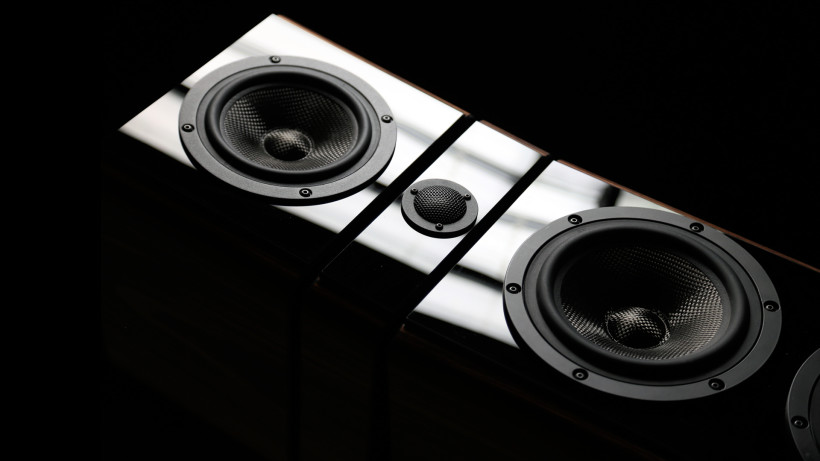 A word about Audioform speakers series is in order. Adventure is described as the one able to deliver the most truthful and spatial experience, whereas Nord is designed to meet the demands of those who look for raw, amorphous and Scandinavian alike furniture, complemented by the sound on the cooler side. Classic family looks the most monolithic and uncomplicated out of the whole flock. When safe design meets presumably the most colorful sound, this series is the outcome. Let’s get back to Adventure now. Its every model looks similar, yet the difference is in the amount of modules. 301 is the smallest and bass-reflex loaded two-way design, whereas 302 ups the ante by one. 303 is similar to the latter, albeit its bass module is a closed box with two drivers instead of one. On the very adventurous top sits 304 model. It sports four modules and four ways, though its lowest one is vented. This review’s main dish is conceptually 303 alike, yet a bit more user friendly, namely designed to work with amplifiers able to deliver about 200W into eight ohms and not 100 more.
A word about Audioform speakers series is in order. Adventure is described as the one able to deliver the most truthful and spatial experience, whereas Nord is designed to meet the demands of those who look for raw, amorphous and Scandinavian alike furniture, complemented by the sound on the cooler side. Classic family looks the most monolithic and uncomplicated out of the whole flock. When safe design meets presumably the most colorful sound, this series is the outcome. Let’s get back to Adventure now. Its every model looks similar, yet the difference is in the amount of modules. 301 is the smallest and bass-reflex loaded two-way design, whereas 302 ups the ante by one. 303 is similar to the latter, albeit its bass module is a closed box with two drivers instead of one. On the very adventurous top sits 304 model. It sports four modules and four ways, though its lowest one is vented. This review’s main dish is conceptually 303 alike, yet a bit more user friendly, namely designed to work with amplifiers able to deliver about 200W into eight ohms and not 100 more.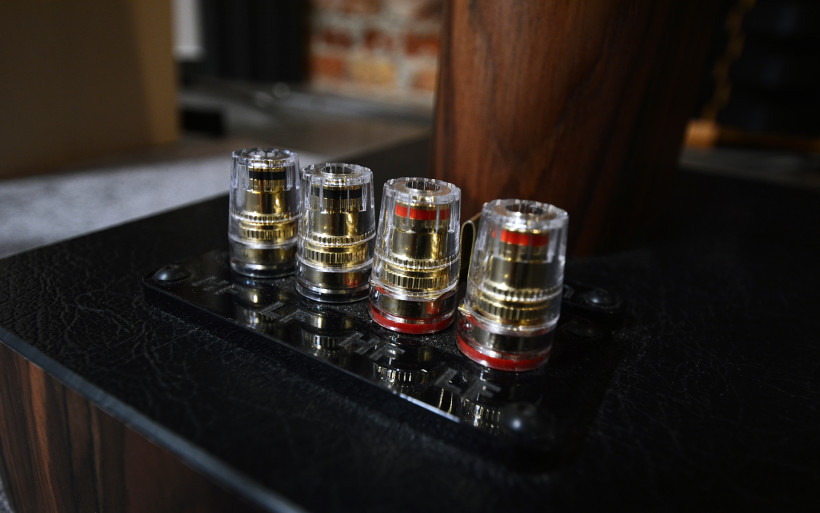 Audioform 203.5 model is very well-made. Every module is based on a sandwich type box. The main ingredient is bent ply on the sides whereas MDF sits at the bottom and the top to make the enclosure properly stiff. Natural veneers are applied on module’s sides and back, leather goes on top and thick acrylic alike finish sits on speaker’s front. Audioform has four veneers available; zebrano, white zebrano, wenge and gray oak. Moving on, 203.5 looks peculiar. Because of modular features, inherent uniqueness is the visual outcome, but that’s not even the fracture of this story. Every Adventure floorstander is placed on a rather thick and large leg fitted onto a massive base loaded with two pairs of nice speaker terminals. Manufacturer’s on-site description mentions that wood is one of key materials in this family and I believe that it’s used in said elements. It’s easy to see that every module’s back is rounded. Not only it sports some additional uniqueness to already striking visual appearance, but is Audioform’s way of dealing with pesky standing waves inside driver’s chambers.
Audioform 203.5 model is very well-made. Every module is based on a sandwich type box. The main ingredient is bent ply on the sides whereas MDF sits at the bottom and the top to make the enclosure properly stiff. Natural veneers are applied on module’s sides and back, leather goes on top and thick acrylic alike finish sits on speaker’s front. Audioform has four veneers available; zebrano, white zebrano, wenge and gray oak. Moving on, 203.5 looks peculiar. Because of modular features, inherent uniqueness is the visual outcome, but that’s not even the fracture of this story. Every Adventure floorstander is placed on a rather thick and large leg fitted onto a massive base loaded with two pairs of nice speaker terminals. Manufacturer’s on-site description mentions that wood is one of key materials in this family and I believe that it’s used in said elements. It’s easy to see that every module’s back is rounded. Not only it sports some additional uniqueness to already striking visual appearance, but is Audioform’s way of dealing with pesky standing waves inside driver’s chambers.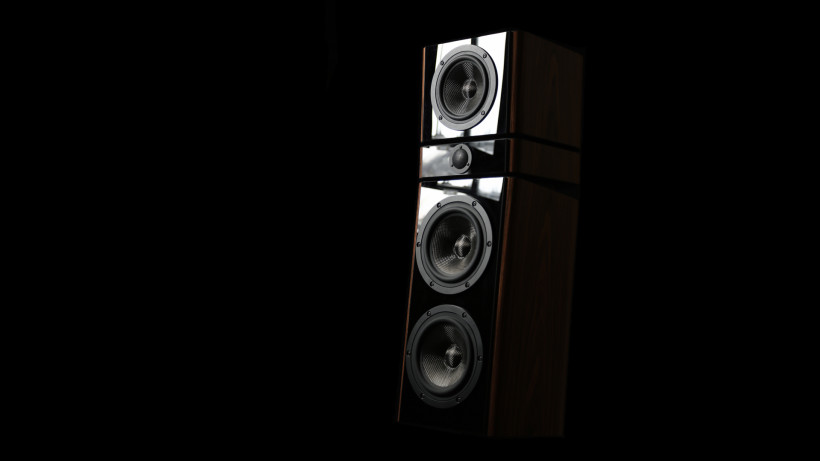 Two passive crossovers are fixed at speaker’s bases. The filtration is of third order, hence the product’s fairly low efficiency. Crossover points are set at 350 and 4000 Hz. The first one deals with two 6.5 inch STX drivers in bass module, whereas the other handles one inch tweeter based on a titanium dome. 5.1 inch STX widebander is left alone and frisky. But it’s worth to know that the same two units in bass module work differently. Each has its own chamber, though these are connected via small inner port, which is tuned to resonate at 46 Hz. And second driver is cut-off at 3000 Hz. Every STX product sports a kevlar membrane and an aluminum basket. It’s also worth to know that, aside tweeter’s module, every module is heavily damped with diffusers made out of extruded PS material. This input in particular is based on M. R. Schroeder’s discoveries. And lastly, each 203.5 speaker weighs 30 kg, its impedance is set at eight ohms with local drops to six, whereas 89 dB efficiency closes this chapter.
Two passive crossovers are fixed at speaker’s bases. The filtration is of third order, hence the product’s fairly low efficiency. Crossover points are set at 350 and 4000 Hz. The first one deals with two 6.5 inch STX drivers in bass module, whereas the other handles one inch tweeter based on a titanium dome. 5.1 inch STX widebander is left alone and frisky. But it’s worth to know that the same two units in bass module work differently. Each has its own chamber, though these are connected via small inner port, which is tuned to resonate at 46 Hz. And second driver is cut-off at 3000 Hz. Every STX product sports a kevlar membrane and an aluminum basket. It’s also worth to know that, aside tweeter’s module, every module is heavily damped with diffusers made out of extruded PS material. This input in particular is based on M. R. Schroeder’s discoveries. And lastly, each 203.5 speaker weighs 30 kg, its impedance is set at eight ohms with local drops to six, whereas 89 dB efficiency closes this chapter.
Sound
At first, yours truly honestly thought that this assignment will be of a walk in the park type. Big speakers, though closed. And enough space to handle ’em on top of that. At least according to manufacturer’s say. What could possibly go wrong here? Gosh, was I naive. The issues emerged from the very beginning, but not with the speakers. On the contrary to their interaction with this journalist’s man cave. But before we get into that matter, let’s focus on how 203.5 performs as a package, namely what kind of an animal it is.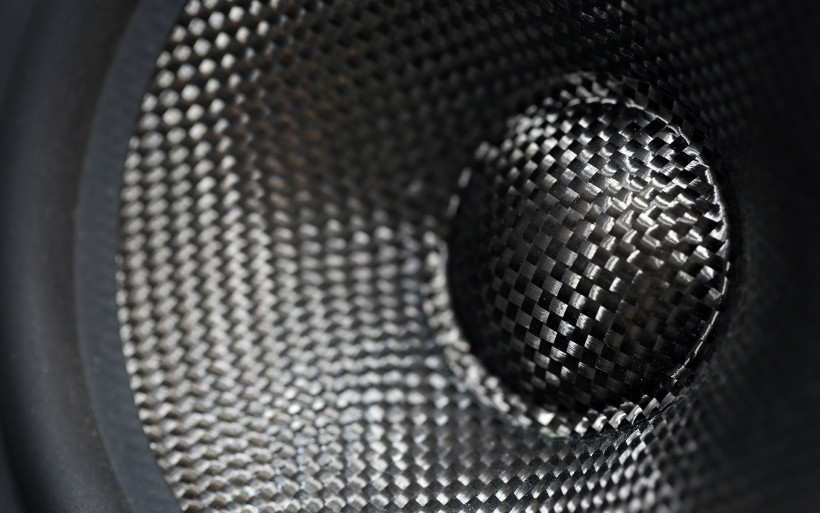 Closed design nets a peculiar outcome in terms of bass. One should know that if on manufacturer’s and room’s ends everything is dandy, no boominess downstairs, the speed, agility and feistiness should be the pleasant outcome. Picture Magico in the high-end realm and ATC offering way below. These are merely two out of many brands’ examples known for sealed enclosures. Tomasz Kursa, as an active drummer, values rhythmics above all else. He has to and there’s no other way around it, he needs to feel the punch and impulse. Bass precise, punchy and detailed, yet potentially as well-textured as it can be and not overbearing is how he likes it. To cut with the suspense, 203.5 model represents his taste. It’s heard and felt that he wanted to make himself a pair of speakers which would serve him as an auditioning tool of grand precision. Once again, aforementioned product fits this description perfectly. Not merely in terms of its downstairs reproduction, but overall.
Closed design nets a peculiar outcome in terms of bass. One should know that if on manufacturer’s and room’s ends everything is dandy, no boominess downstairs, the speed, agility and feistiness should be the pleasant outcome. Picture Magico in the high-end realm and ATC offering way below. These are merely two out of many brands’ examples known for sealed enclosures. Tomasz Kursa, as an active drummer, values rhythmics above all else. He has to and there’s no other way around it, he needs to feel the punch and impulse. Bass precise, punchy and detailed, yet potentially as well-textured as it can be and not overbearing is how he likes it. To cut with the suspense, 203.5 model represents his taste. It’s heard and felt that he wanted to make himself a pair of speakers which would serve him as an auditioning tool of grand precision. Once again, aforementioned product fits this description perfectly. Not merely in terms of its downstairs reproduction, but overall.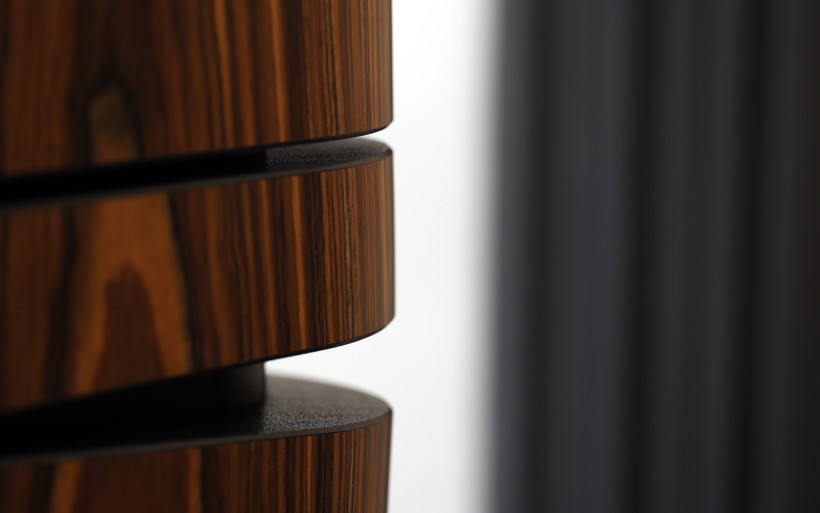 Tight grip over bass aside, what else one gets? It quickly turned out that 203.5 model delivers somewhat detail oriented performance. With bass this well-controlled and highs mildly elevated, it’s safe to say that the outcome is precise, yet a bit V-shaped tonal balance is on the table. That was this journalist’s initial impression. In headphones realm we’d recognize performance of this sort as a joy provider. Jumpy bottom and elevated treble serves that purpose. Rock music anyone? In normal circumstances yes, that exactly. But described tonality shifts and rhythmics are only a part of the proper rock outcome. In order to make our musical picture complete, some safe amount of saturation is needed. Here things were better than expected. Well, STX brand is known for drivers designed to meet professional demands, therefore fitness and not muscular mass oriented. But 203.5 has what it takes to make the guitar sound like guitar and vocals like vocals. Though it’s heavily setup dependent, actually quite flexible in this regard. It’ll show quite clearly what setup’s input is. Let me elaborate on this part a bit.
Tight grip over bass aside, what else one gets? It quickly turned out that 203.5 model delivers somewhat detail oriented performance. With bass this well-controlled and highs mildly elevated, it’s safe to say that the outcome is precise, yet a bit V-shaped tonal balance is on the table. That was this journalist’s initial impression. In headphones realm we’d recognize performance of this sort as a joy provider. Jumpy bottom and elevated treble serves that purpose. Rock music anyone? In normal circumstances yes, that exactly. But described tonality shifts and rhythmics are only a part of the proper rock outcome. In order to make our musical picture complete, some safe amount of saturation is needed. Here things were better than expected. Well, STX brand is known for drivers designed to meet professional demands, therefore fitness and not muscular mass oriented. But 203.5 has what it takes to make the guitar sound like guitar and vocals like vocals. Though it’s heavily setup dependent, actually quite flexible in this regard. It’ll show quite clearly what setup’s input is. Let me elaborate on this part a bit.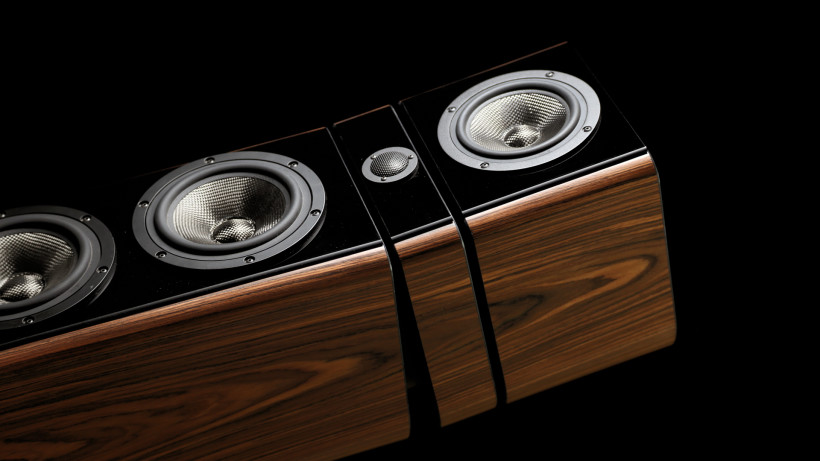 Sanders Sound Systems two-piece set came in as first. Add LampizatOr Golden Gate with rather precise WE101D-L bulbs on-board and the outcome became rather dry. Fast, well-controlled, precise and quite big? Yes. But also dry and that’s a no-go. Trilogy 925 swap netted completely different result. The sound became a bit slower, though gratifyingly dense and of less showy attitude. What came to my attention was the soundstage quite different to what I’m used to. Boenicke W8 painted bigger and more orderly picture. These Swiss floorstanders were also able to show i.e. LampizatOr’s front row intimacy in more precise and effortless fashion. There’s something strangely soothing about said speakers. One gets every information there is, yet in calm, easygoing and distinctive way. In comparison to these boxes, Polish 203.5 model seemed to not sing but fight with the soundstage, which led to weariness in the long run. Even past the accommodation phase, the sensation of constant struggle was present and fatigue quickly followed in the process. Mr Kursa’s product wasn’t able to completely disappear from the room. It goes rather without saying that W8 Swiss model handles this task like a true champ. But that’s not all.
Sanders Sound Systems two-piece set came in as first. Add LampizatOr Golden Gate with rather precise WE101D-L bulbs on-board and the outcome became rather dry. Fast, well-controlled, precise and quite big? Yes. But also dry and that’s a no-go. Trilogy 925 swap netted completely different result. The sound became a bit slower, though gratifyingly dense and of less showy attitude. What came to my attention was the soundstage quite different to what I’m used to. Boenicke W8 painted bigger and more orderly picture. These Swiss floorstanders were also able to show i.e. LampizatOr’s front row intimacy in more precise and effortless fashion. There’s something strangely soothing about said speakers. One gets every information there is, yet in calm, easygoing and distinctive way. In comparison to these boxes, Polish 203.5 model seemed to not sing but fight with the soundstage, which led to weariness in the long run. Even past the accommodation phase, the sensation of constant struggle was present and fatigue quickly followed in the process. Mr Kursa’s product wasn’t able to completely disappear from the room. It goes rather without saying that W8 Swiss model handles this task like a true champ. But that’s not all.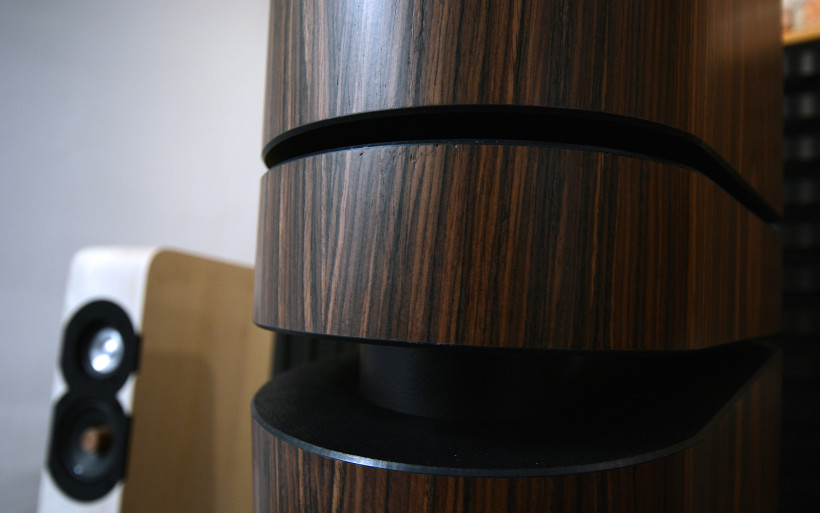 OK, oddball soundstage is one thing, but distorted and boomy bass is a bit too much, which was a part of Polish package as well. During my time with 203.5, I was able to easily grasp its overall characteristic as it’s rather strong. But even though extensive placement measures were taken, said model’s performance downstairs wasn’t of quality all the time. It was uneven. All things considered, something was off either with the product, or with the room. Easy assignment? Yeah, right. Not even close. What happened next was unexpected yet at this point so badly needed. Mr Kursa called to inform me that one of his clients – Mr Maciej Jacenko – would like to have a listen to his product. Not being asocial type, I happily welcomed the man in my place. We gave 203.5 a go versus W8 and after several switches the conclusion was obvious. It was heard that this model has a potential, yet it won’t show it in my place. When something’s this fishy, it’s high time to do some investigation work. In spite of initial dismay as the effect of Polish vs Swiss comparison the two of us conducted, Maciej was still interested in giving 203.5 model a chance at his place. “If manufacturer says yes, by all means please do!” – I replied. My guest gladly exploited the opportunity and what happened next was of rather shocking nature.
OK, oddball soundstage is one thing, but distorted and boomy bass is a bit too much, which was a part of Polish package as well. During my time with 203.5, I was able to easily grasp its overall characteristic as it’s rather strong. But even though extensive placement measures were taken, said model’s performance downstairs wasn’t of quality all the time. It was uneven. All things considered, something was off either with the product, or with the room. Easy assignment? Yeah, right. Not even close. What happened next was unexpected yet at this point so badly needed. Mr Kursa called to inform me that one of his clients – Mr Maciej Jacenko – would like to have a listen to his product. Not being asocial type, I happily welcomed the man in my place. We gave 203.5 a go versus W8 and after several switches the conclusion was obvious. It was heard that this model has a potential, yet it won’t show it in my place. When something’s this fishy, it’s high time to do some investigation work. In spite of initial dismay as the effect of Polish vs Swiss comparison the two of us conducted, Maciej was still interested in giving 203.5 model a chance at his place. “If manufacturer says yes, by all means please do!” – I replied. My guest gladly exploited the opportunity and what happened next was of rather shocking nature.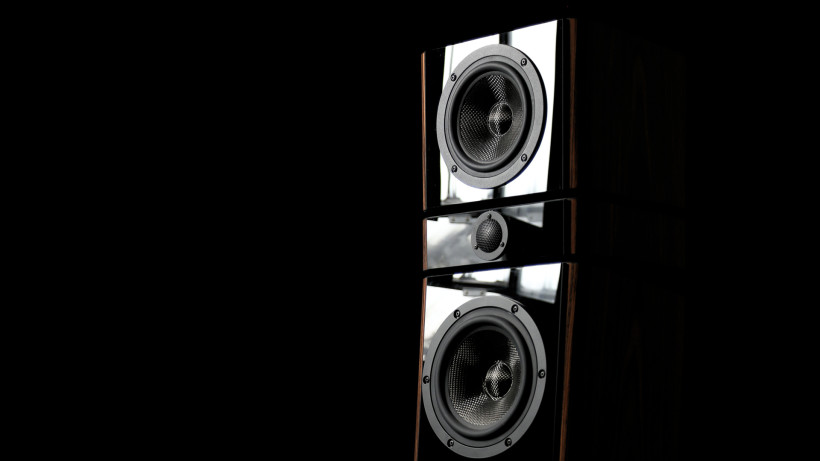 Several days after our meet, Maciej called me to give his report as promised. I wish I knew more people this reliable. Moving on, to my great surprise he told me that the outcome at his place was much better. How much? Vastly. Aha! This was the invitation I simply couldn’t refuse. Not only we’re practically neighbors, his setup is quite familiar to yours truly. Maciej lives in a 120 sq. meters flat and his listening place is an impressive half of that. Living room merged with kitchen shenanigans is practical from family’s perspective, yet not necessarily audiophile friendly. But it is what it is, we roll with what we have. Maciej is rather happy with heavily modified, Duelunds loaded LampizatOr Level4.5 and Modwright KWA100SE to name just two, albeit crucial components. To make it short, in said gent’s environment, 203.5 performed much better in comparison to my joint.
Several days after our meet, Maciej called me to give his report as promised. I wish I knew more people this reliable. Moving on, to my great surprise he told me that the outcome at his place was much better. How much? Vastly. Aha! This was the invitation I simply couldn’t refuse. Not only we’re practically neighbors, his setup is quite familiar to yours truly. Maciej lives in a 120 sq. meters flat and his listening place is an impressive half of that. Living room merged with kitchen shenanigans is practical from family’s perspective, yet not necessarily audiophile friendly. But it is what it is, we roll with what we have. Maciej is rather happy with heavily modified, Duelunds loaded LampizatOr Level4.5 and Modwright KWA100SE to name just two, albeit crucial components. To make it short, in said gent’s environment, 203.5 performed much better in comparison to my joint.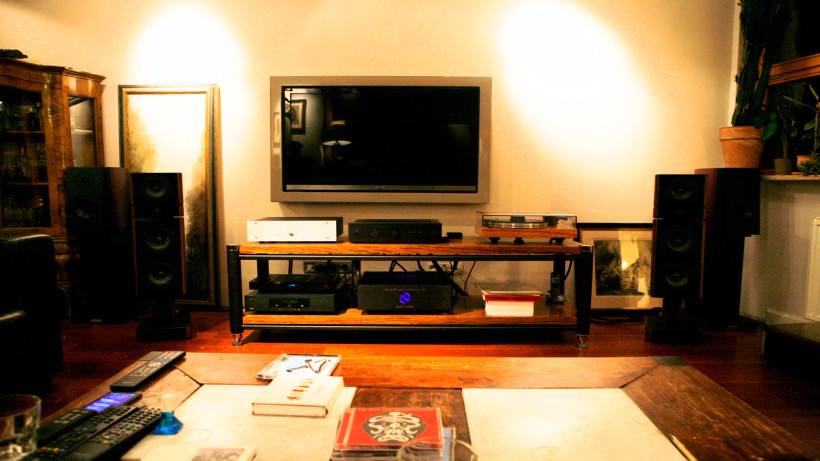 The speakers’ overall sound character remained the same. But the best part was that its bass became grand in terms of quality and the soundstage became properly orderly. That struggle impression above? It was completely gone. The turn of events this unexpected showed us both to what exactly Mr Kursa’s product is capable of. The sound, still of precise nature, became more fluent, presumably due to lack of any room interference. Bass got a bit thicker, yet as punchy as before and greatly textured. Without audible boominess input it was, dare I say, spectacular as a package. Not a single thing I’d change in 203.5’s downstairs department, honestly. And because of its additive, complementary and not overwhelming attitude, remaining FR became more material than before. The soundstage was impressively expansive widewise, yet a bit peculiar. Said model usually made it audibly shorter with most of recordings. It helped a bit to lower oneself in a sofa. But the point was that only one or two tracks, dare I say very well-recorded, out of many listened had proper height. Also, 203.5 model focused our attention on the very first row, its projection wasn’t as deep as the one generated by my W8’s. Yes, the sound was still rather upfront. But in comparison to what I’ve encountered in my manly cave, the outcome was on a completely different, much higher and very enjoyable level. What’s even more surprising is that 203.5 were able to perform music in a very subtle way. Not as ethereal and delicate as Swiss champs, yet polite and of quality when needed. The takeaway for this chapter is that Polish speakers performed unexpectedly well in the second room. If one is able to pull off the outcome this good, aforementioned speakers’ asking is simply justified, that’s the bottom line.
The speakers’ overall sound character remained the same. But the best part was that its bass became grand in terms of quality and the soundstage became properly orderly. That struggle impression above? It was completely gone. The turn of events this unexpected showed us both to what exactly Mr Kursa’s product is capable of. The sound, still of precise nature, became more fluent, presumably due to lack of any room interference. Bass got a bit thicker, yet as punchy as before and greatly textured. Without audible boominess input it was, dare I say, spectacular as a package. Not a single thing I’d change in 203.5’s downstairs department, honestly. And because of its additive, complementary and not overwhelming attitude, remaining FR became more material than before. The soundstage was impressively expansive widewise, yet a bit peculiar. Said model usually made it audibly shorter with most of recordings. It helped a bit to lower oneself in a sofa. But the point was that only one or two tracks, dare I say very well-recorded, out of many listened had proper height. Also, 203.5 model focused our attention on the very first row, its projection wasn’t as deep as the one generated by my W8’s. Yes, the sound was still rather upfront. But in comparison to what I’ve encountered in my manly cave, the outcome was on a completely different, much higher and very enjoyable level. What’s even more surprising is that 203.5 were able to perform music in a very subtle way. Not as ethereal and delicate as Swiss champs, yet polite and of quality when needed. The takeaway for this chapter is that Polish speakers performed unexpectedly well in the second room. If one is able to pull off the outcome this good, aforementioned speakers’ asking is simply justified, that’s the bottom line.
Summary
Audioform 203.5 turned out to be a very peculiar and fun giving performer. Yes, with certain demands to be met in order to grasp all of its features and quality. But, as it states above, if one is able to deliver proper setup and environment, and is into very lively, jumpy and mildly contour performance, a great outcome is for the taking.
203.5 model is picky in terms of recordings quality and electronics. For some of you this is good, not so much for the rest. Said product plays in the upfront team. This trait translates to the outcome not sugarcoated but honest, simple as that. Without discoveries of this very sort, our hobby would quickly became rather dull. 203.5 model is the exact opposite. It’ll make one’s blood boil instead putting him to sleep, it invigorates instead of playing it safely, it’s a Corvette not Toyota Prius… and so on, so forth. Point being, 203.5 is fast and perfectly happy about it. From our drummer’s perspective it made sense to make speakers with such attitude.
To make this writing’s outcome even better for Mr Tomasz Kursa, 203.5 model is very well-made. Some DIY marks are visible, yes. But this design is of much more complex nature in comparison to a regular monolithic box, that’s unquestionable. And still, our engineer was able to deliver a very uniquely looking, nicely executed product which sounds very good… for slightly more than €4’000 per pair. Kudos. He’s consequent, committed to the case and obviously likes to do things in his own way. That’s a recipe for a success if someone asks me. Sooner or later it’ll come and I’m glad I could spread the word early on. ‘Till next time.
- Loudspeakers: Boenicke Audio W8
- Amplifiers: Trilogy 925, Sanders Sound Sustems Magtech
- Digital source: Lampizator Golden Gate (WE101D-L + 5U4G Ltd. Ed.)
- Interconnects: Albedo Monolith
- Speaker cable: Albedo Monolith
- Power chords: Forza AudioWorks Noir Concept, Gigawatt LC-2 MK2
- Power delivery: Gigawatt PF-2 mk2
- Equipment racks: Lavardin K-Rak
- Music: NativeDSD
- Playback platform: Roon
Retail prices of reviewed components in EU:
- Audioform 203.5: €4’350 (excl. tax)
Manufacturer: Audioform


